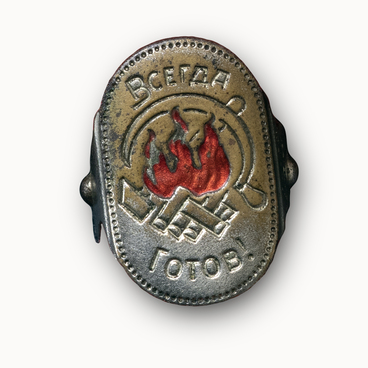The medical gown and surgical instruments from the Museum of the History of Obninsk belonged to Praskovya Pavlovna Firsova. Firsova’s gown is green, a shade that replaced the traditional white in the second half of the 20th century. White coats were considered a symbol of cleanliness and were easier to treat with bleach. But green is more suitable to wear during surgeries because it helps surgeons see better. It is the most soothing color for the human eye and the opposite of red, a strong irritant. Surgeons have to look at blood a lot during surgeries, which gradually reduces the sensitivity of their eyes to red. Green helps to balance out the strain.
Praskovya Firsova was born in 1916. In 1940 she entered the Second Moscow Medical Institute, but her studies were cut short by the war. Praskovya Pavlovna served in the ranks of the active army, becoming a paramedic at a field hospital. In 1943 during an artillery attack she was wounded, shell-shocked, and after recovery could not fight any more. Praskovya Pavlovna returned to the student’s classroom and continued her studies. In 1946, at the age of 30, she received her diploma from the Second Moscow Medical Institute.
Praskovya Firsova learned a great deal from Alexander Alexandrovich Vishnevsky, professor, Chief Surgeon of the USSR Ministry of Defense, Colonel-General of the Medical Service. She worked with him at the Vishnevsky Institute of Surgery, named after the father of Alexander Alexandrovich. Praskovya Pavlovna defended her dissertation and earned a PhD and then became a Doctor of Medicine.
In 1965, Firsova came to Obninsk, where she organized and headed a surgical department at the newly established Institute of Medical Radiology. Soon Praskovya Pavlovna was awarded the title of Professor and Honored Worker of Science of the RSFSR. Firsova was a talented surgeon, she brought back to life patients who were hopelessly ill. Thousands of patients saved from deadly diseases were to her credit. She conducted unique surgical operations and gave scientific consultations up to the last days of her life.
Praskovya Pavlovna Firsova died in 2002 and is buried in Obninsk at the Konchalovsky cemetery.
Praskovya Firsova was born in 1916. In 1940 she entered the Second Moscow Medical Institute, but her studies were cut short by the war. Praskovya Pavlovna served in the ranks of the active army, becoming a paramedic at a field hospital. In 1943 during an artillery attack she was wounded, shell-shocked, and after recovery could not fight any more. Praskovya Pavlovna returned to the student’s classroom and continued her studies. In 1946, at the age of 30, she received her diploma from the Second Moscow Medical Institute.
Praskovya Firsova learned a great deal from Alexander Alexandrovich Vishnevsky, professor, Chief Surgeon of the USSR Ministry of Defense, Colonel-General of the Medical Service. She worked with him at the Vishnevsky Institute of Surgery, named after the father of Alexander Alexandrovich. Praskovya Pavlovna defended her dissertation and earned a PhD and then became a Doctor of Medicine.
In 1965, Firsova came to Obninsk, where she organized and headed a surgical department at the newly established Institute of Medical Radiology. Soon Praskovya Pavlovna was awarded the title of Professor and Honored Worker of Science of the RSFSR. Firsova was a talented surgeon, she brought back to life patients who were hopelessly ill. Thousands of patients saved from deadly diseases were to her credit. She conducted unique surgical operations and gave scientific consultations up to the last days of her life.
Praskovya Pavlovna Firsova died in 2002 and is buried in Obninsk at the Konchalovsky cemetery.


